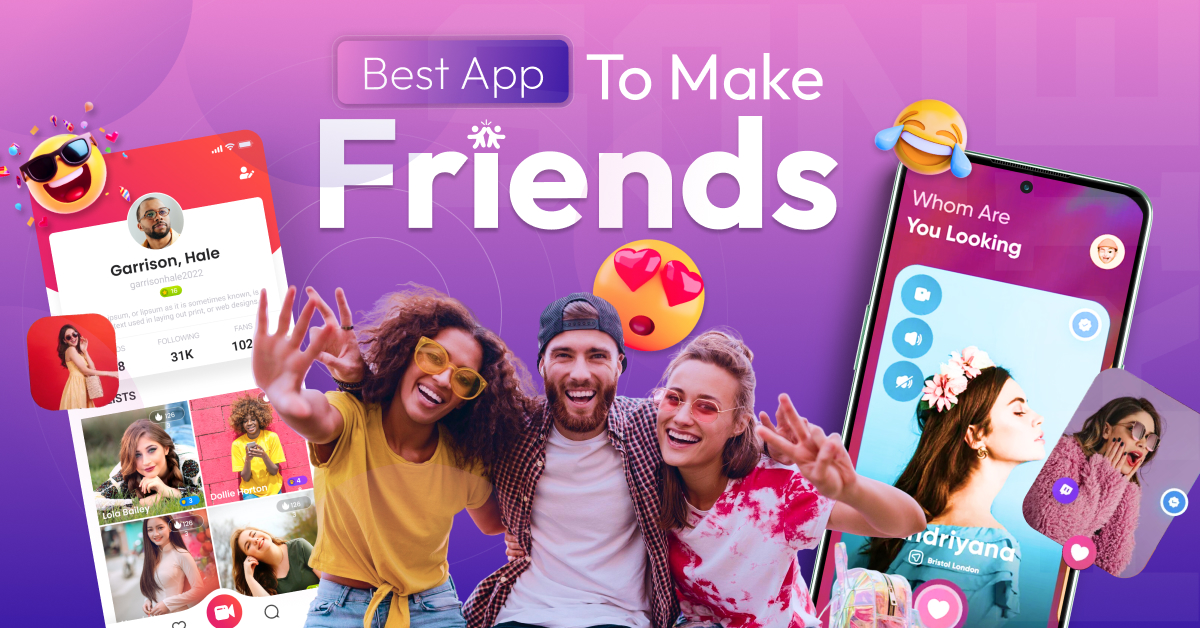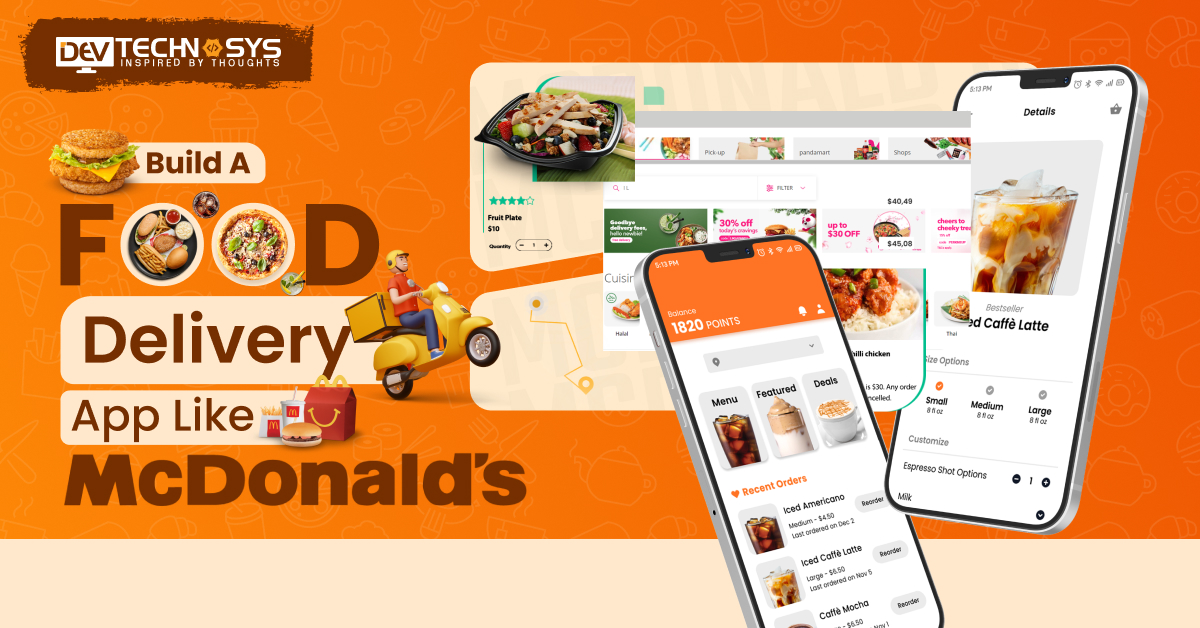Quick Summary:Learn about the AI text-to-video app development cost. From basic features to advanced AI algorithms, discover estimated costs based on app complexity and features and many other benefits of developing it.
Have you heard about Open AI Sora? Yes, you got it right! Open ai Sora is an incredible AI text-to-video app development that was recently released on Thursday, 15th Feb 2024. It’s causing a bizarre buzz in everyone’s mind as it was unexpectedly launched with practical functionality.
Hence, if you haven’t heard, Sora is a groundbreaking AI tool that turns text into stunning and engaging videos, which has increased the demand for knowing AI text-to-video app development cost estimation.
Many of you didn’t just learn that the global market for converting text to video using artificial intelligence (AI) is expected to reach $900 million by 2027, growing at a significant rate of 37.1% annually. This rapid growth is driven by the best text-to-video AI app technologies, which are leading to the creation of more innovative AI-powered applications.
Numerous entrepreneurs are looking forward to developing AI text-to-video apps after witnessing the functionality of Sora. So, are you one of the people who are updated across the globe and want to follow the technology trends? Then, this is the opportunity to lead the market.
Grab some fruits and take a seat to give this blog a minute to read and learn about the accurate AI text-to-video app development cost and multiple other benefits of developing it. Dive straight!
What is an AI Text-to-Video App?
An AI text-to-video app is a device that makes use of artificial intelligence to create motion pictures out of your written textual content. Imagine giving the app a script, and it robotically generates a video with visuals, voiceover, or even tune, all based totally on your entry.
These Android or iPhone app developments with AI may nevertheless be beneficial for developing short and clean motion pictures for social media, displays, or academic functions.
Introduction of Open AI Sora: AI Text-to-Video App
Open AI Sora, launched in February 2024, is an AI-powered app that transforms textual content descriptions into practical movies. While not publicly available, it is generating buzz for its potential to create unique scenes, complicated digital camera moves, or even characters with feelings, all within a 60-2d timeframe. We have compiled Open Ai Sora’s uses, benefits, and work in one of our blogs, which you may find helpful to know more about.
10 Popular AI Text-to-Video Apps
Before you dive into the section to learn about AI text-to-video app development costs, you must look at the best AI video generator apps.
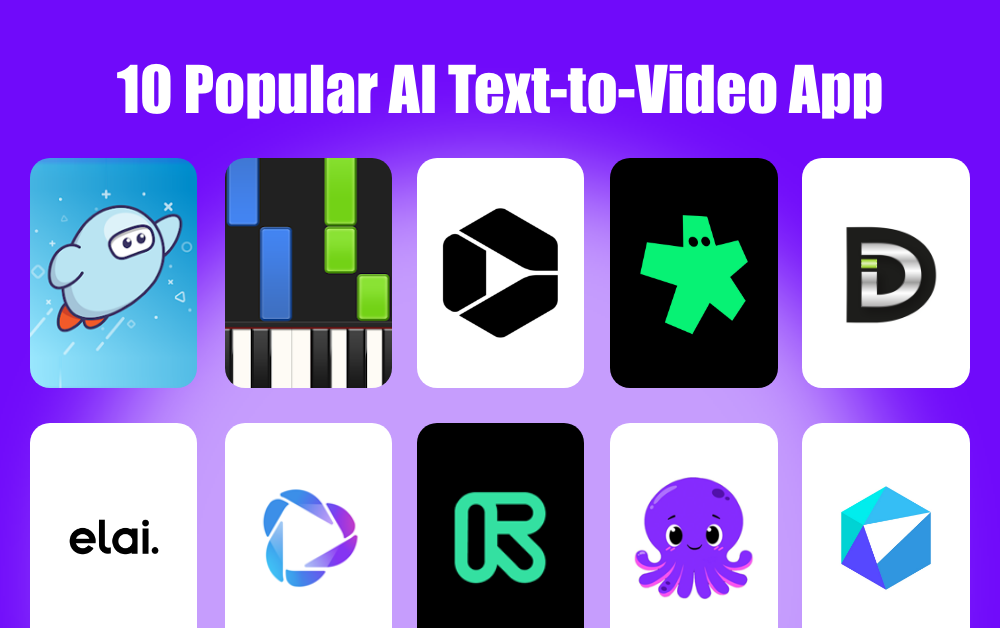
| App Name | Launch Date | Rating | Platforms |
| Sora | 15 Feb 2024 | 4.0 | Web |
| Synthesia | 2017 | 4.5 Stars | Web, Windows, Mac |
| Colossyan | 2021 | 4.2 Stars | Web |
| Hour One | 2020 | 4.3 Stars | Web |
| D-ID | 2018 | 4.7 Stars | Web |
| Elai.io | 2020 | 4.4 Stars | Web |
| HeyGen | 2022 | 4.1 Stars | Web |
| Runway | 2018 | N/A (Open-source) | Web |
| Pictory | 2016 | 4.6 Stars | Web |
| Deepbrain AI | 2020 | 4.0 Stars | Web |
Average AI Text-to-Video App Development Cost
The average AI text-to-video app development cost can vary from $10,000 to $30,000 based totally on numerous factors, including the complexity of features, platform compatibility, design intricacy, and AI app development company quotes. Here’s a breakdown of the anticipated cost to build a Text-to-Video App with simple, average, and complex functionalities:
|
Complexity Level |
Description |
Estimated Cost |
|
Simple |
Basic features such as text-to-video conversion, basic templates, and minimal customization options. |
$8,000 – $16,000 |
|
Average |
Additional features like advanced customization options, premium templates, integration with external services, and user analytics. |
$16,000 – $30,000 |
|
Complex |
Advanced AI algorithms, extensive customization capabilities, support for multiple platforms (web, iOS, Android), robust backend infrastructure, and real-time collaboration features. |
$30,000+ |
It is vital to know that these estimates of the cost to develop a text-to-video app are hard averages and may range extensively depending on factors with the Android app development services providers’ geographical vicinity, the app’s precise necessities, and the extent of expertise required. Additionally, ongoing maintenance and updates have to be factored into the average AI text-to-video app development cost.
Read More: Open AI’s Sora
7 Factors Affecting the AI Text-to-Video App Development Cost
The rapidly growing artificial intelligence (AI) has opened doors to incredible possibilities, and one such captivating software is the textual content-to-video app. These text-to-video AI generators can generate dynamic visuals primarily based on textual descriptions, doubtlessly revolutionizing storytelling, education, advertising, and more.
However, growing such an app entails complicated strategies and costs that could range substantially. Now that you know the average cost to develop a mobile application for text to video converting features, you must know some of the essential factors that affect the overall cost of making an AI Text-to-Video App.
- Complexity of AI Model
- Functionality and Features
- Development Team and Location
- Design and User Interface (UI)
- App Maintenance and Updates
- Data Collection and Training
- Cloud Infrastructure and Hosting
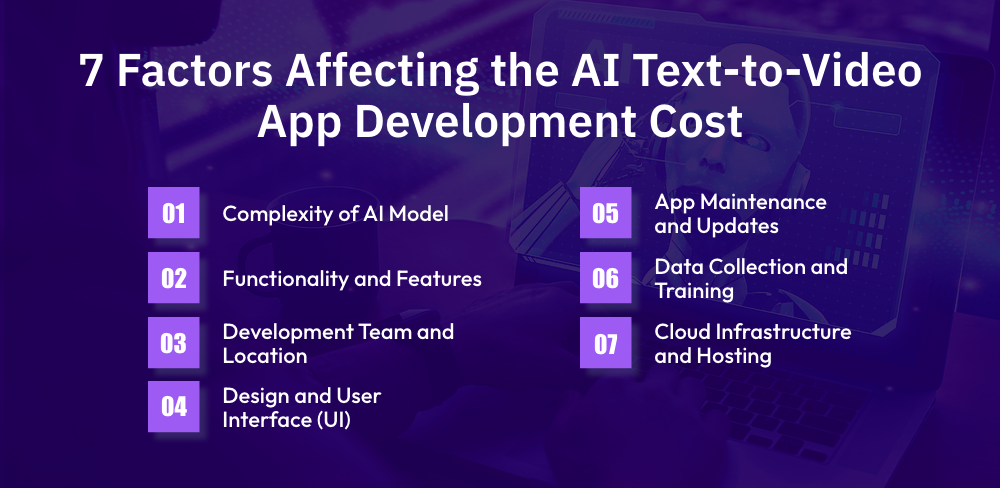
1. Complexity of AI Model:
- Basic Technology: This includes producing simple visuals based on primary keywords and terms. It utilizes pre-trained models without problems available via open-supply structures, keeping AI text-to-video app development costs incredibly low.
- Advanced Technology: This level entails generating complicated and unique visuals, regularly requiring custom-educated fashions on particular datasets. This customization necessitates more excellent development time and expertise, leading to higher AI tools to convert text to video costs.
- Multimodal Abilities: If the app is ambitious to include diverse media formats like audio and text along with visuals, the complexity and increase in the AI text-to-video app development cost similarly because of the need for more tricky version integration.
2. Functionality and Features:
- Basic Capability: This consists of features like text entry, basic video technology, and accessible modifying alternatives. Apps with constrained features require much less development time and support, translating to lower costs.
- Advanced Capability: More advanced features like style customization, scene transitions, and complicated user animation require extra development effort, leading to better AI text-to-video app development costs.
- Customization and Integration: ChatGPT integration services and other structures, presenting numerous video output codecs and allowing user-generated content functions, further grow the complexity of AI text-to-video app development cost.
3. Development Team and Location:
- Team Size and Experience: A prominent mobile app development company with skilled developers, AI experts, and designers will clearly cost more due to mixed salaries and knowledge. However, their performance can also expedite development, doubtlessly offsetting some fees.
- Team Location: AI text-to-video app development costs can vary drastically depending on the location of the ML development company. Hourly costs for developers range significantly between areas, with higher costs commonly associated with North America and Western Europe and lower charges in some Asian and Eastern European nations.
4. Design and User Interface (UI):
- Simple UI: A primary, intuitive interface with limited animation and interaction elements has a lower AI text-to-video app development cost.
- Complex UI: Sophisticated user interfaces with enticing animations, interactive elements, and superior customization options require great layout and development effort, which is mainly due to better AI text-to-video app development costs.
5. App Maintenance and Updates:
- Regular Updates: Maintaining and updating the app to address insects, enhance performance, and incorporate new functions require ongoing development assets, which are mainly due to ongoing AI text-to-video app development costs.
- Limited Updates: Apps with minimal planned updates incur lower mobile app maintenance services; however, they could need more support or user satisfaction as the era evolves.
6. Data Collection and Training:
- Pre-Educated Fashions: Utilizing readily available, pre-educated models minimizes facts series and training costs.
- Custom Training: Building a custom AI model from scratch calls for considerable information collection, curation, and instruction time, extensively increasing the cost to build a mobile app.
7. Cloud Infrastructure and Hosting:
- Local Hosting: The text to the video generator app in your servers would appear cost-effective initially. However, it requires significant hardware funding, preservation, and ability scalability obstacles.
- Cloud-based Website Hosting: Utilizing cloud platforms like Google Cloud Platform (GCP) or Amazon Web Services (AWS) gives scalability, flexibility, and pay-as-you-cross models, which can be more fee-powerful in the end, particularly for resource-in-depth best AI text to video generator app.
How To Reduce AI Text-to-Video App Development Cost?
Text-to-video apps powered by artificial intelligence (AI) have received broad awareness because of their capability to convert text into videos. However, developing such apps may be highly priced. This blog section outlines eight strong measures to reduce AI text-to-video app development costs without compromising on first-class or functionality.
- Define Clear Requirements
- Utilize Open-Source Tools and Libraries
- Optimize Cloud Infrastructure Usage
- Adopt Agile Development Methodology
- Outsource Non-Core Functions
- Reuse Existing Components and Modules
- Prioritize MVP (Minimum Viable Product) Development
- Invest in Continuous Optimization and Maintenance

1. Define Clear Requirements:
Before diving into development, it is essential to define clear and straightforward necessities in your text-to-video app. It consists of outlining functions, functionalities, audiences, and structures.
By having an in-depth roadmap, natural language processing services providers can avoid useless iterations and consciousness of essential components, thereby saving time and resources.
2. Utilize Open-Source Tools and Libraries:
Leveraging open-source tools and libraries can notably reduce development costs. Many AI frameworks, including TensorFlow and PyTorch, offer pre-skilled techniques and sources for natural language processing (NLP) and computer vision responsibilities. By utilizing these resources, generative AI development companies can accelerate development and reduce the need to build models from scratch.
3. Optimize Cloud Infrastructure Usage:
Instead of investing in high-priced on-premises infrastructure, bear in mind utilizing cloud offerings such as Amazon Web Services (AWS), Google Cloud Platform (GCP), or Microsoft Azure.
These AI text-to-video generators provide scalable computing sources, garage, and AI services on a pay-as-you-cross basis, permitting you to optimize AI text-to-video app development costs primarily based on utilization and avoid premature investments.
4. Adopt Agile Development Methodology:
Adopting an agile development technique permits iterative development and continuous analysis loops. By breaking down the assignment into more minor duties or user stories, IoT app development company can prioritize functions based on their cost and complexity.
This approach no longer most effectively fosters collaboration but additionally permits for early detection of problems, reducing the general artificial intelligence text to video app development time and cost.
5. Outsource Non-Core Functions:
Consider outsourcing non-center features, which include UI/UX layout, QA checking out, or backend development for specialized corporations or freelancers.
Outsourcing allows you to tap into outside information without the overhead prices associated with hiring complete-time employees. Moreover, outsourcing can help in reaching quicker time-to-market and flexibility in scaling assets based on undertaking requirements.
6. Reuse Existing Components and Modules:
Reuse present additives, modules, or code snippets anyplace viable to avoid reinventing the wheel. Whether it’s integrating third-party APIs for speech synthesis or leveraging open-supply video editing libraries, reusing the latest solutions can appreciably lessen text-to-video AI app development efforts and costs. However, ensure the proper licensing and compatibility while incorporating external components into your app.
7. Prioritize MVP (Minimum Viable Product) Development:
Focus on developing a Minimum Viable Product (MVP) with crucial capabilities that address middle user needs. By prioritizing MVP development, you can quickly validate your AI transcribe video-to-text app idea, collect user comments, and iterate based on real-international usage.
This technique not only minimizes upfront investment but also mitigates the threat of creating needless features that may not resonate with users.
8. Invest in Continuous Optimization and Maintenance:
After launching your text-to-video generation app, put money into non-stop optimization and maintenance to make sure its lengthy period is successful. Monitor user engagement metrics, gather feedback, and iterate on features to beautify user experience and deal with any overall performance troubles.
By investing in ongoing optimization and protection, you can extend the lifecycle of your on-demand app development solutions and maximize their ROI.
7 Monetization Techniques of AI Text-to-Video App: Get ROI on Cost
Monetizing an AI textual content-to-video app may be a multifaceted enterprise, requiring strategic making plans and execution. Here are seven monetization techniques that permit you to obtain a return on funding (ROI) on the cost to build AI text-to-video app:
- Subscription Model
- In-App Purchases
- Advertisement Integration
- Freemium Model
- White Label Solutions
- API Access and Integration
- Premium Content Marketplace
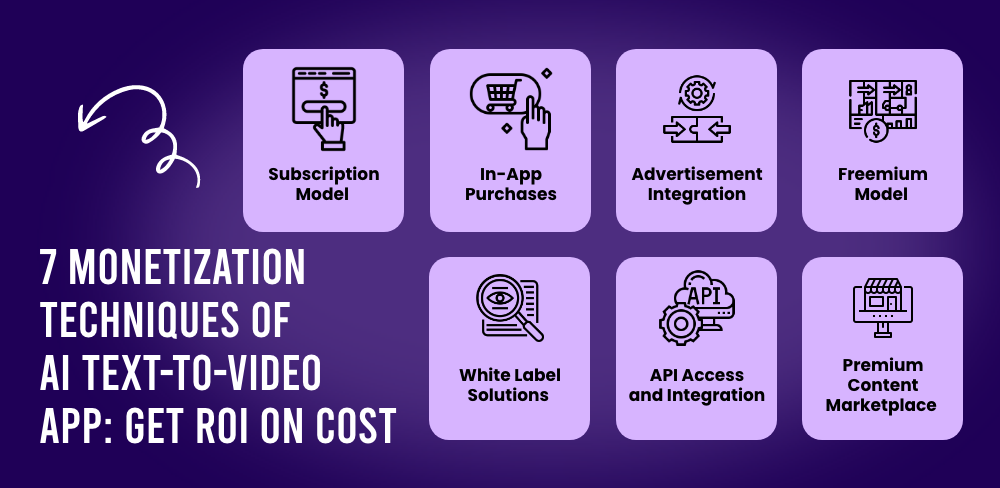
1. Subscription Model:
Implementing a subscription-based model can be a powerful way to generate regular revenue from your AI text-to-video app. Offer users distinctive subscription stages with various capabilities and advantages, such as getting the right of entry to premium templates, higher best exports, or advanced customization alternatives.
You can also provide a loose trial period to lure users to sign up and experience the total capacity of the artificial intelligence text-to-video app.
2. In-App Purchases:
Incorporate in-app purchases to unlock extra content material, functions, or functionality inside the app. It should include top-class video templates, computer graphics, licensed music tracks, or custom branding alternatives. By imparting precious add-ons that beautify the user experience, you could inspire users to make purchases and grow your revenue streams.
3. Advertisement Integration:
Integrate classified ads into your app to monetize user engagement. It can encompass display ads, video commercials, or subsidized content that appears within the app interface.
Consider partnering with applicable advertisers or ad networks to target your audience effectively and maximize ad revenue. However, an understanding of not disrupting the user reveals immoderate or intrusive ads.
4. Freemium Model:
Adopt a freemium model where the basic version of the app is offered totally free, but users pay to free up top-class capabilities or eliminate boundaries.
This method allows you to attract a more extensive user base with a loose imparting while monetizing a subset of users who are willing to pay for an added price. It’s critical to strike the proper balance between what is offered totally free and what calls for a cost to make sure users see the price of upgrading.
5. White Label Solutions:
Offer white-label solutions for your AI text-to-video app to companies or folks who want to leverage the era for their purposes. It ought to encompass content creators, marketers, or businesses trying to combine automated video advent into their workflow.
Provide customizable versions of the app that can be rebranded and tailor-made to meet the specific desires of your user, charging licensing expenses or royalties for the privilege.
6. API Access and Integration:
Provide get entry to your app’s API (Application Programming Interface) to allow chatbot development company to integrate its functionality into their platforms or offerings.
It may want to open up possibilities for partnerships, integrations, or third-party plugins that enlarge the reach of your app to new audiences. Charge developers for API utilization are based totally on elements, including the volume of requests or the extent of entry to be granted, growing a scalable sales movement.
7. Premium Content Marketplace:
Create a market within your app wherein users can purchase and promote premium video content material, templates, or belongings. It can foster a network of creators who contribute to the ecosystem, even by imparting to users a greater variety of alternatives to choose from. Take a per cent of each transaction as a fee price, incentivizing content material creators to take part and using sales through the market.
Why Are AI Text-to-Video Apps a Goldmine for Entrepreneurs?
The AI generation has revolutionized diverse industries, and the empire of content advent isn’t any exception. AI textual content-to-video apps, just like the recently disclosed OpenAI’s Sora, a wholly unique and beneficial possibility for entrepreneurs looking to benefit from a competitive area. Learn some incredible benefits to develop an AI app like Sora for industrial success.
- Enhanced Marketing and Advertising
- Improved Scalability and Efficiency
- Accessibility and Democratization
- Increased Engagement and Conversions
- Exploring New Markets and Revenue Streams
- Staying Ahead of the Curve
1. Enhanced Marketing and Advertising:
Engaging video content material is essential for powerful advertising and advertising. AI text-to-video apps empower marketers to create centred video ads, explainer videos for products and services, and social media content material tailor-made to unique audiences, all at a fraction of the standard value. This flexibility allows for A/B to try out unique video patterns and messaging to optimize campaigns and maximize ROI.
2. Improved Scalability and Efficiency:
As a commercial enterprise grows, the introduction of content material frequently increases exponentially. AI text-to-video apps can cope with this scalability venture by enabling the creation of numerous motion pictures in a shorter time frame.
It allows entrepreneurs to be aware of other strategic factors in their business while making sure of a consistent waft of fresh content material to hold target audience engagement.
3. Accessibility and Democratization:
Traditionally, video manufacturing has been a domain that is ordinarily available to massive businesses with giant resources. AI text-to-video apps get rid of this barrier, making excellent video introductions reachable to any entrepreneur or small business. It empowers them to compete on a stage, playing a subject with larger businesses in terms of content material introduction and brand storytelling.
4. Increased Engagement and Conversions:
Studies show that video content material is notably more engaging than text-based totally content material. Viewers are more likely to keep data supplied in a video format, mainly with expanded logo recognition and advanced stamps in mind. AI text-to-video apps permit marketers to leverage this power of video to create charming content that resonates with their audience, in the long run, riding conversions and sales.
5. Exploring New Markets and Revenue Streams:
AI text-to-video apps open doors to new revenue streams for marketers. They can offer video introduction services to other agencies, create academic video guides, or create an AI text-to-video app with custom video templates for particular industries. It expands their enterprise reach and opens doorways to untapped sales opportunities.
6. Staying Ahead of the Curve:
The use of AI in various industries is hastily growing. By investing in AI textual content-to-video app development, entrepreneurs demonstrate their dedication to innovation and staying ahead of the curve. It can attract investors, potential partners, and users who value groups embracing modern-day technology.
Know How We Can Help You Build a Text-to-Video App In 1 Steps?
Hopefully, you liked this blog, and now you know the AI text-to-video app development cost. In this blog, we have tried compiling almost everything, from AI text to video development, its factors affecting monetization strategies and why new entrepreneurs must invest in building text-to-video apps like Sora. Hence, you must be thinking about why we said we could help you develop an app like Synthesia in one step.
Stop wondering! Connect through the chatbox through our experts, as we have knowledgeable professionals who handle your query related to development. If you are someone who wants to invest in AI text-to-video app development, don’t sit back. Hire dedicated developers right away from us and see your app idea turning into reality in just one click. Want to see a magic… Connect!
Frequently Asked Questions
Q1. What is AI Text-to-Video App Development Cost?
The cost to Build a Text-to-Video App can range from $10,000 to $30,000+, depending on features, complexity, and development team location.
Q2. How to Build an AI Text-to-Video App?
- Ideation and planning: Define your app’s purpose, target audience, and features.
- Data collection and training: Gather and curate text data to train the AI model for video generation.
- Development: Build the app’s user interface, integrate the AI model, and ensure functionality.
- Testing and refinement: Thoroughly test the app, address bugs, and refine the AI model for optimal performance.
- Deployment and maintenance: Launch the app, gather user feedback, and continuously update and maintain it.
Q3. Why Choose Dev Technosys For AI Text-to-Video App Development?
Consider Dev Technosys for your AI text-to-video app development because:
- We have experience building similar AI-powered applications.
- We offer a competitive development cost and timeline.
- We possess a team of skilled developers and AI experts.
- We prioritize client communication and satisfaction.

















